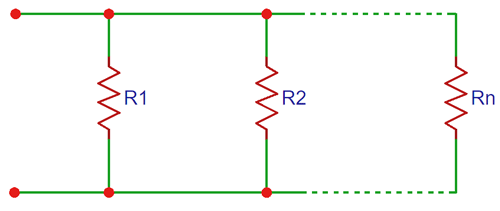

Working of the Parallel Circuit Resistance Calculator
This parallel resistance calculator calculates the total resistance value for all the resistors connected in parallel. Simply add the number of resistors and enter each resistance value with the proper unit (Ω, KΩ, or MΩ) to calculate parallel circuit resistance instantly.
When resistors are connected in parallel, the equivalent resistor is lower than the lowest resistor among all the resistors connected in parallel. It is because when we add a new resistor in parallel, it opens a new way to pass the current. This total resistance calculator uses the principle that parallel connections create multiple current paths, reducing overall circuit resistance.
The formula used by this parallel circuit resistance calculator is:
1/RTotal=1/R1+1/R2+1/R3+...+1/RnHere you can find the Calculator for Resistors in Series.
How to Use the Parallel Resistor Calculator
-
Enter Number of Resistors: Specify how many resistors you want to calculate (2-10 supported)
-
Input Resistance Values: Enter the resistance value for each resistor
-
Select Units: Choose between Ohm (Ω), Kilo Ohm (KΩ), or Mega Ohm (MΩ) for each resistor
-
Calculate: Click "Calculate" to use our parallel resistance calculator online and get your total parallel resistance
-
Clear: Use the "Clear" button to reset all values and start over
Understanding the Parallel Resistance Formula
When you calculate parallel circuit resistance, the fundamental formula is essential for electrical engineering:
1/R_total = 1/R₁ + 1/R₂ + 1/R₃ + ... + 1/Rₙ
This formula shows that parallel resistors create multiple paths for current flow, resulting in lower total resistance than any individual resistor in the circuit.
Why This Parallel Circuit Resistance Calculator Shows Lower Values
When you use this parallel circuit resistance calculator, it provides additional pathways for electrical current. Think of it like adding more lanes to a highway - more lanes allow more traffic (current) to flow, reducing overall resistance to flow.
Practical Applications of Parallel Resistors
LED Lighting Circuits
Parallel resistors are commonly used in LED arrays to ensure consistent brightness and current distribution across multiple LEDs.
Audio Crossover Networks
Audio systems use parallel resistor networks to divide frequencies between different speakers (tweeters, woofers, mid-range).
Power Distribution Systems
Electrical power grids use parallel resistance principles to distribute electricity efficiently across multiple branches.
Current Limiting Applications
Parallel resistors help limit current in sensitive electronic circuits while maintaining proper voltage levels.
Common Parallel Resistor Calculations
Two Identical Resistors in Parallel
For two identical resistors (R), the parallel resistance is R/2. For example:
-
Two 100Ω resistors in parallel = 50Ω
-
Two 1KΩ resistors in parallel = 500Ω
-
Two 10KΩ resistors in parallel = 5KΩ
Standard Resistor Combinations
Popular parallel combinations for achieving specific resistance values:
-
150Ω + 300Ω = 100Ω
-
220Ω + 330Ω = 132Ω
-
470Ω + 1KΩ = 320Ω
Professional Reference: Standard Parallel Resistor Combinations
Professional engineers often need standard resistance values quickly. This total resistance calculator reference table shows common parallel combinations using standard E12 resistor values:
|
Resistor 1 |
Resistor 2 |
Parallel Result |
Application |
|---|---|---|---|
|
100Ω |
100Ω |
50Ω |
LED current limiting |
|
220Ω |
330Ω |
132Ω |
Audio circuits |
|
470Ω |
1000Ω |
320Ω |
Signal processing |
|
1kΩ |
2.2kΩ |
688Ω |
Voltage dividers |
|
4.7kΩ |
10kΩ |
3.2kΩ |
Pull-up resistors |
When you calculate parallel circuit resistance for standard values, always verify results with this parallel resistance calculator online to account for component tolerances.
Frequently Asked Questions
⇥ Why is parallel resistance always lower than individual resistors?
Parallel connection creates multiple paths for current flow. More paths = less resistance to current flow = lower total resistance.
⇥ How many resistors can I calculate in parallel?
Our calculator supports up to 10 resistors in parallel. For more resistors, calculate groups separately and combine results.
⇥ Can I mix different units (Ω, KΩ, MΩ) in one calculation?
Yes! Our calculator automatically handles unit conversions. You can mix Ohms, Kilo Ohms, and Mega Ohms in a single calculation.
⇥ What's the difference between series vs parallel resistance?
-
Series: R_total = R₁ + R₂ + R₃... (resistances add up)
-
Parallel: 1/R_total = 1/R₁ + 1/R₂ + 1/R₃... (reciprocals add up)
⇥ How accurate is this parallel resistor calculator?
Our calculator provides results accurate to 6 decimal places, suitable for most engineering and educational applications.
Related Circuit Calculators
Explore our other electrical engineering calculators:
Tips for Circuit Design
Choosing Parallel Resistor Values
When designing circuits with parallel resistors:
-
Use standard resistor values when possible (E12 or E24 series)
-
Consider power dissipation across each resistor
-
Account for resistor tolerance in critical applications
-
Calculate worst-case scenarios with tolerance variations
Power Considerations
In parallel circuits, power is distributed across resistors. Lower resistance resistors carry more current and dissipate more power. Use this formula: P = I²R = V²/R, or use our resistor power calculator to calculate the power rating required for your resistors.
Related Electrical Calculators for Resistor Networks
Explore these related electrical calculators to complement your resistor network designs. From series and parallel configurations to voltage division and power ratings, these tools simplify circuit analysis.
Use this LED resistor calculator to find out the suitable resistance for your LED circuit consisting of one or more LEDs.This LED resistor calculator will help you pick the right value of resistor for the LED in your LED circuit. You just have to input the values of Source voltage (Vs), LED forward current (If) and LED forward voltage (Vf).
Use this LED resistor calculator to find out the suitable resistance for your LED circuit consisting of one or more LEDs. Every LED has its characteristics and specifications, depending on the materials used to make them, their colour and many other parameters. As we know, the LEDs have a forward voltage, just like any other diode.
LM317 Resistor/Voltage Calculator
Enter the R1 and R2 resistor values in the LM317 calculator below to calculate the output voltage, OR you can enter the target output voltage and R1 and calculate the required value of R2.LM317 is an adjustable voltage regulator which takes an input voltage of 3 - 40V DC and provides a fixed output voltage of 1.25V to 37V DC.




